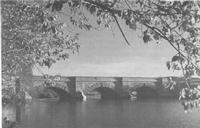


Chapter 6
I Construction During The Settlement Years
II The Use Of Timber As A Structural Material
III Structural Steel
IV Concrete Technology
V Housing
VI Industrialised Pre-cast Concrete Housing
VII Ports And Harbours
VIII Roads
IX Heavy Foundations
X Bridges
XI Sewerage
XII Water Engineering
XIII Railways
XIV Major Buildings
XV Airports
XVI Thermal Power Stations
XVII Materials Handling
XVIII Oil Industry
XIX The Snowy Mountains Scheme
XX The Sydney Opera House
XXI The Sydney Harbour Bridge
XXII Hamersley Iron
XXIII North West Shelf
Sources and References
Index
Search
Help
Contact us

By the time Governor Phillip set foot in Farm Cove, our vast continent had been occupied for 40,000 years by the Aboriginal people, during which period there was very little evidence of technological ingenuity. They used, however, some ingenious fish traps, they had fashioned some primitive implements, and constructed some simple stone shelters. In spite of tribal wanderings for centuries over vast mineral resources, they had neither identified deposits of copper or iron, nor developed the techniques for using these materials. It is surprising, also, that they had not learned how to use the country's virtually unlimited supplies of fossil fuels for heating purposes. Phillip was confronted with a vast country, which had a varied and often harsh climate, extensive deserts, limited water and was completely devoid of technical resources. Not only were the great distances a problem within the country, but as Geoffrey Blainey pointed out in his book, The Tyranny of Distance, its distance from the resources of Europe, with long journeys over turbulent seas, most certainly impeded early physical development.
The building of the nation began on 26th January, 1788, in the oppressive heat of a Sydney midsummer's day. Marines paraded, while convicts toiled and swore, felled the trees, cleared the ground, set up a forge, landed provisions and erected the first structures in Australia. A search for construction materials immediately after the landing had revealed some fine stands of timber and vast deposits of sandstone. The problem was how to adapt European technology for their effective utilisation. It was found that the local timbers were particularly hard to work with the tools sent out with the First Fleet, since tradesmen had been accustomed to the soft woods of Europe. Not only were the local timbers difficult to work, but shrinkage, warping and splitting also caused many structural and water penetration problems. During the summer, the baked countryside, the hardness of the local rocks, and the unaccustomed properties of local timbers rendered those early tools almost useless. More tools were sent out two years later, but they were of the same inferior quality and maintenance was such a constant problem that tradesmen, at their locally established forge, fabricated their own superior implements from scrap metals obtained from the ships.
There was a great shortage of skilled labour and the convict labour which was available in those early days was, to say the least, unwilling to work and more interested in resisting authority than in effective production. The situation improved with the advent of Governor Macquarie, who adopted a more liberal attitude to pardons for those who performed to satisfactory standards.
There were vast deposits of sandstone in and around Sydney, a material which was relatively easy to quarry and shape, and with the inspiration of former convict architect-engineer Francis Greenway, many splendid public buildings were produced from this material. In concept and design most of them followed European traditions, but some of them, particularly the later buildings, developed a distinctive style not widely recognised at the time, but now known as the Greenway style.
The basalts of Victoria and Tasmania were much harder to use. Quarrying and cutting bluestone blocks without pneumatic tools were body breaking tasks, but the architects and masons used them with skills equivalent to those which had mastered similar unaccustomed tasks in New South Wales. Their buildings were durable, solid and in many cases splendidly proportioned. A prominent early architect-civil engineer was John Lee Archer, who was appointed Civil Engineer and Colonial Architect to Van Dieman's Land in 1826. He was responsible for all its government buildings, including those for penal and military purposes: they include Parliament House and Anglesea Barracks. The virtues of his designs were good proportion, simplicity and stability, influenced by his knowledge of the Georgian Renaissance period. This has given Hobart a unique architectural character. Archer's engineering competence was more clearly identified with his work on masonry bridges, the most outstanding example of which is the arch bridge over the Macquarie River at Ross (Fig. 1). It still serves today and, with its impeccable proportions and scenic surroundings, is a popular attraction for tourists.

Organisations in Australian Science at Work - Anglesea Barracks, Hobart
People in Bright Sparcs - Archer, John Lee; Greenway, Francis; Holland, Sir John
 |
Australian Academy of Technological Sciences and Engineering |  |
© 1988 Print Edition pages 311 - 312, Online Edition 2000
Published by Australian Science and Technology Heritage Centre, using the Web Academic Resource Publisher
http://www.austehc.unimelb.edu.au/tia/312.html